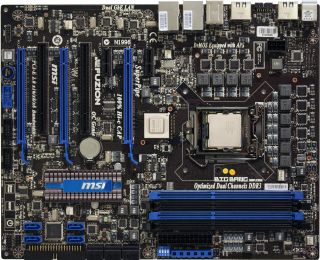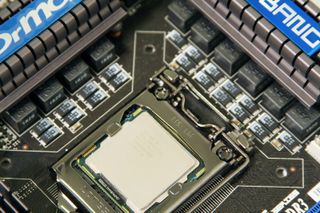MSI Big Bang Fuzion: Pulling The Covers Off Of Lucid’s Hydra Tech
MSI’s Big Bang Fuzion Motherboard
Before we break into the nuts and bolts of Hydra, let’s talk about MSI’s Fuzion motherboard—the reason we’re even able to explore the work Lucid has done in multi-GPU rendering.

Based on a similar board layout as the P55-GD80 that Thomas reviewed in his $200-$250 P55 motherboard roundup, and even closer to the Big Bang Trinergy in his upcoming $250+ roundup (which you’ll see next week), the Big Bang Fuzion is unquestionably a premium part at $350. Because the Lynnfield- and Clarkdale-based CPUs that drop into it are limited to 16 total lanes of on-package PCI Express 2.0 connectivity, it’s up to the Hydra 200 chipset to mux a 16-lane connection into a pair of 16-lane links. The Fuzion also supports x16/x8/x8 configurations, but if you’re doing any more than two cards, P55, in general, is not the way we’d go. Beyond that, the third x16 slot is located at the very bottom of the board, so any dual-slot card would hang off anyway, requiring a case with special concessions for additional slot counts.
Because the Fuzion board comes with Lucid’s Hydra, MSI doesn’t make a big deal over CrossFire or SLI. However, you can disable Hydra and run in CrossFireX mode, since that’s natively supported by Intel’s P55 platform. You cannot, however, revert to SLI in the event you discover an incompatibility with your dual-GPU solution running under Hydra. Thus, it’s particularly important that everything work the way it should with Hydra turned on.

As with most LGA 1156 platforms, the Fuzion sports four memory slots that tap into the Lynnfield/Clarkdale dual-channel on-package controller. Officially, both processor families support up to DDR3-1333, but MSI naturally enables overclocked transfer rates as high as DDR3-2133.
Twin gigabit Ethernet controllers, on-board FireWire 400, four additional SATA 3 Gb/s ports enabled by JMicron JMB322 port multipliers, and two extra eSATA ports enabled by a JMicron JMB362 controller are all part of this board’s enthusiast-class spec sheet. MSI further adds value through its PCI Express x1 QuantumWave sound card, employing Realtek’s ALC889 codec. The card’s specs are heavily licensed from Creative and include EAX Advanced 5.0, ALchemy, and THX TruStudio PC. That latter feature itself consists of a suite designed to compensate if you lack a subwoofer, fill in missing dynamic range, and “intelligently” applying gain/attenuation.

MSI’s other differentiators include tantalum surface mount capacitors, which are more reliable due to a tolerance for very warm conditions. They tend to be more expensive than aluminum electrolytic capacitors, which is probably why MSI is showing them off so prominently. There’s also a comprehensive accessory bundle to go along with the board, including an eSATA breakout panel with complementary data/power cables, six internal SATA cables, power adapters for SATA hard drives, an IDE cable, a two port USB 2.0 bracket, copious documentation, labeled jumper blocks, voltage-check leads, and MSI’s custom OC Dashboard. The dashboard is an external device wired in to a connector on the Fuzion’s rear panel, similar to Asus’ TurboV remote. It’s able to report temperatures/fan speeds, adjust voltages, tweak BCLK frequencies, and display debug codes at boot-up. It’s all hardware-based, so there’s no real need to worry about the sometimes-iffy software apps that accompany some of the top-end boards from other vendors.
Stay on the Cutting Edge
Join the experts who read Tom's Hardware for the inside track on enthusiast PC tech news — and have for over 25 years. We'll send breaking news and in-depth reviews of CPUs, GPUs, AI, maker hardware and more straight to your inbox.
Current page: MSI’s Big Bang Fuzion Motherboard
Prev Page It Began With A Bang! Next Page The Many Heads Of Hydra-
Maziar Nice article,its very good for users for upgrading,because for current SLI/CF you need 2 exact cards but with Lucid you can use different cards as well,but it still needs to be more optimized and has a long way ahead of it,it looks very promising thoughReply -
Von_Matrices I'm highly doubtful of the Steam hardware survey. I think it is underestimating the number of multi-GPU systems. I for one am running 4850 crossfire and steam has never detected a multi-GPU system when I was asked for the hardware survey. The 90% NVIDIA SLI seems also seems a little too high to me.Reply -
Bluescreendeath The CPU scores for the 3D vantage tests are way off. You need to turn off PhysX when benchmarking the CPU or it will skewer the results...Reply -
Bluescreendeath So far, the best scaling has been in Crysis. The 5870/GTX285 combo benchmarks looked very promising.Reply -
cangelini BluescreendeathThe CPU scores for the 3D vantage tests are way off. You need to turn off PhysX when benchmarking the CPU or it will skewer the results...Reply
It's explained in the analysis ;-) -
kravmaga "But when you spend $350 on a motherboard, you’re using graphics cards that cost more than that. If you’re not, you aren’t doing it right"Reply
Quoted from the last page; I disagree with that statement.
There are plenty of people in situations where using this board is a better investment performance per dollars. This is all the more relevant as this technology will undoubtedly find its way into cheaper boards and budget oriented setups where it will make all the sense in the world to bench it using mid-end value parts.
I, for one, would have liked to see what using gtx260s and 5770s would look like in this same setup. As is, this review leaves many questions unanswered. -
SpadeM Well the review does give an answer in the form of: It's better to run a ATI card for rendering and a nvidia card for physics and cuda (if u're into transcoding/accelerating with coreavc etc.) with windows 7 installed.Reply
Or at least that is the conclusion i'm comfortable with at the moment. -
HalfHuman i also agree with the fact that a person who will buy this board will necessarily go for the highest priced vid boards. maybe some will but not all. there will be more who will try to save the older vid cards.Reply
i also understand why you paired the 5870 with nvidia's greatest. there is a catch however... lucid guys did not have the chance to play with 5xxx series too much and you may be evaluating something that is not too ripe. i guess the 4xxx series would have been a better chance to see how well the technology works. couple that with games that are not yet certified for lucid, couple that with how much complexity this technology has to overcome... i think this is a magnificent accomplishment o lucid team part.
i also think that in order for this technology to become viable it will go down in price and will be found in much cheaper boards. for the moment the "experimenting phase" is done on the expensive spectrum. i saw some early comparisons and the scaling was beautiful. i know that the system put together by lucid... but that is fine since that was only a demo to show that it works. judging on how fast this guys are evolving i guess that they will go mainstream this year.
Most Popular


